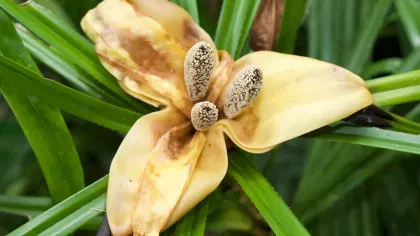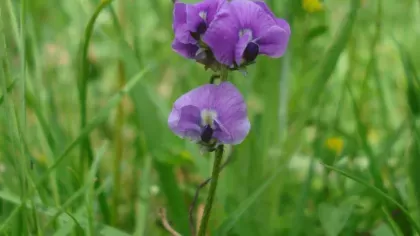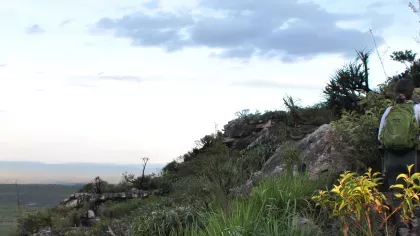17 December 2020
Top 10 species new to science in 2020
Despite 2020's challenges, botanical and mycological science has continued with a bumper list of incredible newly named species being documented with the help of our collaborators across the world.

This year 156 plant and fungal species were named as new to science by Kew scientists and our partners worldwide.
Among these are some amazing new finds for science, each with their own unique qualities and potential for humanity. Some have the potential to be developed into a future food or medicine.
However, the bleak reality facing us cannot be underplayed. With two in five plants estimated to be threatened with extinction, it is a race against time to find, identify, name, and conserve plants before they disappear.
From the ugliest orchid in the world, to a new toadstool from Heathrow Airport, discover some of the weird and wonderful species we've helped to name, with our partners around the world, in 2020.
-

Heathrow Airport fungus
Six new species of webcap toadstool mushrooms have been named in the UK this year, including Cortinarius heatherae (pictured), which was discovered along the river on the boundary of Heathrow airport by field mycologist Andy Overall and named after his wife Heather.
The six new finds are all from the genus Cortinarius, which is ecologically important in supporting the growth of plants, particularly trees such as oak, beech, birch and pine. This genus also plays a key role in the carbon cycling of woodlands and providing nitrogen to trees.
Three were found in Scotland, with two of these named after scientists’ loved ones: C. britannicus, from Caithness in the Highlands and C. scoticus and C. aurae, from a forest in the Black Wood of Rannoch. C. aurae, found by Kew mycologist Tuula Niskanen, was named after her daughter Aura.
The other three were found in England: C. ainsworthii, named after Kew mycologist Martyn Ainsworth, who collected the ‘type specimen’ (the exact specimen on which the name of the new species is based) from Devil’s Dyke, Brighton; C. subsaniosus, found in woods at Barrow-in-Furness.
-

From the frying pan: a strange shrub
A strange shrub was encountered by botanist Wessel Swanepoel in the semi-desert of southern Namibia in 2010. Wessel couldn’t place the shrub in any known genus and neither could anyone else.
Wessel called on Kew’s molecular expert Felix Forest and his team for analysis and results showed that the plant’s DNA fitted the cabbage order, but none of the known families in this order.
It wasn't just a new species, but a new genus and a new family: Tiganophyton karasense (Tiganophytaceae). This is unique, as while around 2,000 plants are named new to science each year, new families are only published around once a year.
The shrub has bizarre scaly leaves and grows in extremely hot natural salt pans, hence its name Tiganophyton, which was derived from the Greek word ‘Tigani’ = frying pan, and ‘Phyton’ = plant.
Fewer than 1,000 plants of the species are known to exist, from just three locations within a small area which experiences the highest temperatures in Namibia, 36°C, with only 4-6 inches of rain per year.
-

Beautiful Brazilian bromeliad
This stunning, colourful bromeliad was discovered in Brazil by Brazilian botanists Pablo Hendrigo Alves de Melo and Gabriel Mendes Marcusso, with Kew scientist Alex Monro in December 2019.
The group encountered the flower on a forest-shaded limestone cliff in central Brazil and named it Acanthostachys calcicola, which means ‘growing on limestone’.
The scientists believe the plant, which is in the same family as the pineapple, is hummingbird pollinated.
Unfortunately, they only found 25 plants, despite searching five other limestone areas nearby. A. calcicola is only the third species of its genus known to science.
Extraction of limestone for cement manufacture is a serious threat for this area, as well as cattle grazing and wood cutting.
Naturally exposed limestone areas often have unique, rare plant species but are threatened around the world by quarrying for raw construction materials and for manufacture of cement, which in turn puts the many species restricted to this area at risk.
-
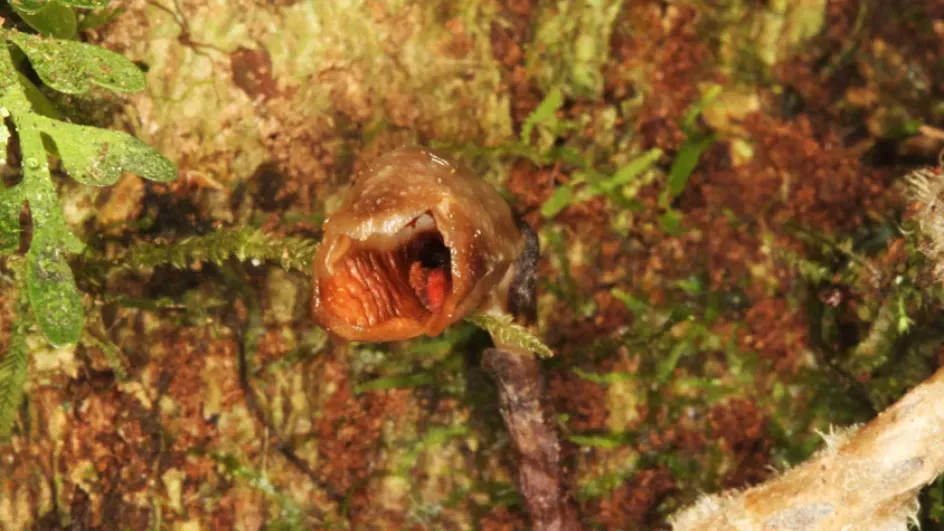
The ugliest orchid in the world
Most people think of orchids as showy, vibrant and beautiful, but Gastrodia agnicellus, newly named this year from a forest in Madagascar, is quite the opposite.
The 11mm flowers of this orchid are small, brown and rather ugly.
After G. agnicellus is pollinated, the stalks grow, holding the fruits well above the forest floor so that the dust-like seeds can better disperse.
The orchid depends on fungi for nutrition and has no leaves or any other photosynthetic tissue.
The new orchid has been assessed as threatened, but with a small range occurring within an already protected national park, the plants do have some protection for now.
-

Say Aloe to two new succulents
Two new species of Aloe have been found and named by Kew scientists based in Kew’s overseas office in Madagascar this year.
Aloe species from Madagascar are usually found in open and sunny areas, but the two new Aloes, A. vatovavensis and A. rakotonasoloi, (pictured), were found in a forest.
The team, led by Solofo Rakotoarisoa, found the plants out of flower, so took them back to the capital Antananarivo to cultivate them. Once the flowers had come out, the species could be confirmed as new to science, and named and published.
It is not yet known if the succulent leaves of both Aloes have the medicinal benefits found in Aloe vera.
-
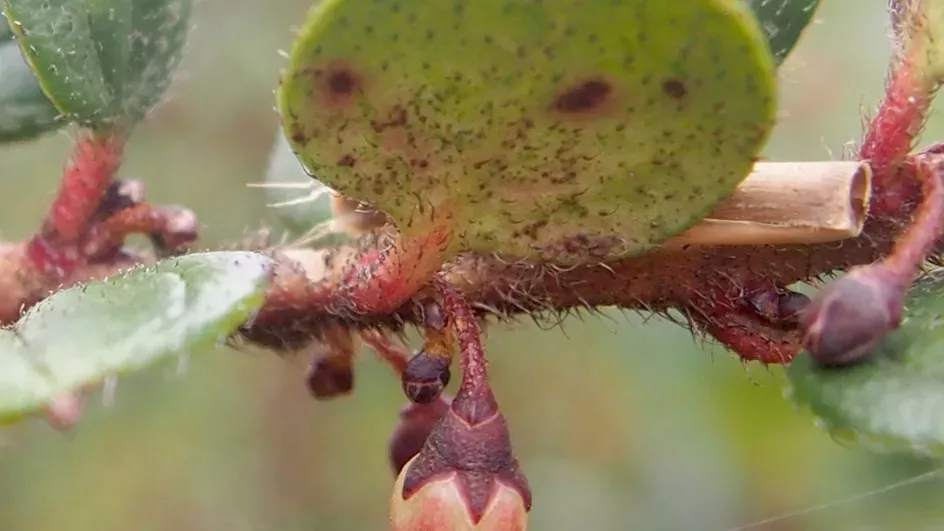
Blue gold
Diplycosia puradyatmikai is a shrub related to blueberries, described this year from Indonesian New Guinea by a group of Indonesian and Kew scientists led by Wendy A. Mustaqim.
The plant grows on the upper slopes of the highest peak in South East Asia, Mt Jaya, rising to nearly 5000m, near the world’s largest gold mine, Grasberg. Its habitat is stunted montane forest, rich in plants from the rhododendron family.
It grows up to 1.5m tall and is characterised by golden-brown bristles on its stems, round leathery leaves and red-tinged bell-shaped flowers.
About 120 species are known in the genus and they are usually found on high mountains, from Indochina to New Guinea.
-

New herb from a medicinally important plant family
Marsdenia chirindensis was newly named in 2020 by Kew scientist David Goyder, who spent 30 years studying this and related plants.
There are around 150 species of Marsdenia scattered through the tropics.
The plant is from the medicinally important family Apocynaceae, which contains species which are used by people as dyes, or to treat a number of health issues such as flatulence, gonorrhoea, paralysis, burns, and fungal skin infections.
This species is restricted to the botanically well-known and species-diverse Chirinda forest of Zimbabwe on the border with Mozambique. Only one or two plants are known to exist.
The medicinal efficacy of this species has not yet been tested, but it could have great potential.
-

Discovered online
This spectacular, red-flowered Hibiscus hareyae with jagged petals was discovered online by an Australian Hibiscus specialist Lex Thomson.
The beautiful plant, which originates from a coastal scrub in Southern Tanzania, was found by Lex who was studying online images of historic herbarium specimens.
He recognised that these specimens had several major features never seen before in the well-known and widely cultivated lookalike species H. schizopetalus, which is found in Southeast Kenya.
Lex named the flower after Dr Hareya Fassil, who has worked on traditional plant-based medicines in Africa.
The new plant has great horticultural potential as it can withstand much drier conditions than the well-known H. schizopetalus.
-
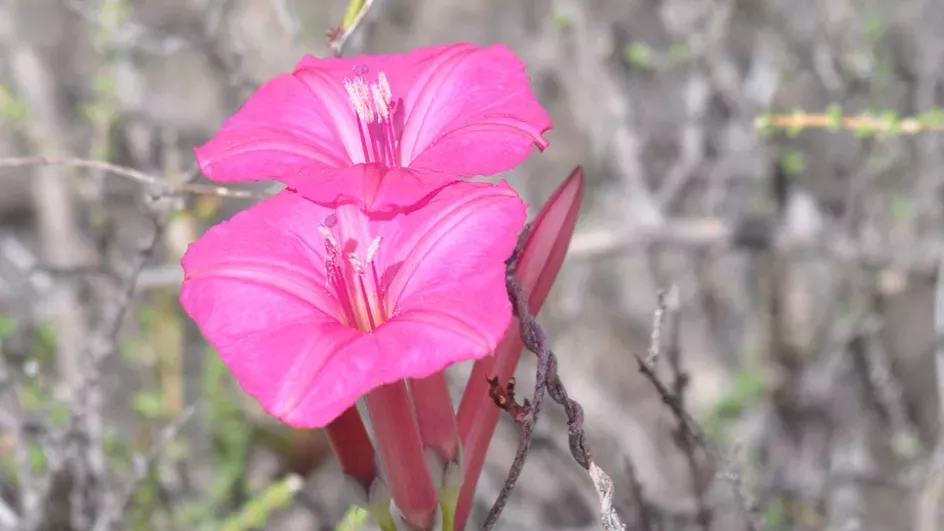
More than just a pretty face...
Not all species newly named by scientists are new to humanity as this pretty pink morning glory, Ipomoea noemana, demonstrates.
Sometimes, species have in fact been well-known and even used by local communities for decades; they have simply remained unknown and invisible to the scientific world.
This plant, from the genus that gives us the sweet potato, was known to local communities in the high Andes of Peru as ‘yura’.
The plant grows among cacti at 2,300m elevation, and features purple tubers up to 10cm in diameter, which can be eaten raw. Locals speak of its sweet taste.
The flower was published and named for the Peruvian philanthropist Noema Cano this year by a team of Peruvian researchers led by Enoc Jara, of the National University of San Marcos in Lima, with John Wood (Kew and Oxford).
It has yet to be analysed for its nutritional value and agricultural potential but it is hoped that this attractive plant could have potential as a new food crop.
-

19 new orchids from New Guinea
An incredible 19 new tree-dwelling orchids, all from New Guinea, were named by Kew’s orchid specialist Andre Schuiteman this year, with help from partners, including Reza Saputra in Indonesia, Jaap Vermeulen in the Netherlands, and Lisa Thoerle in the USA.
The naming of these new orchids has resulted from years of dedicated study from Andre and his collaborators across Indonesia, the Philippines, the USA and the Netherlands, to find out more about the orchids of the world’s most biodiverse tropical island.
The new species include three conventionally attractive species from the Dendrobium genus, including one cultivated behind the scenes in Kew Gardens’ tropical nursery, with spectacular bright golden orange flowers (Dendrobium aurifex - pictured).
The remaining 16 new species are from the Bulbophyllum genus, many of which are fly-pollinated, with the more sinister flowers having tufts of hair reminiscent of features of the human face. The species’ Latin names reflect this: ‘moustached Bulbophyllum’, the ‘Bulbophyllum with sideburns’ and ‘the dagger-tongued Bulbophyllum’.
Many of these orchids have only been found once and some are only known from a single preserved specimen, so scientists do not yet know if they are rare and endangered or occur more widely on the insufficiently explored island of New Guinea.
Species publications
Hyde, K.D., Dong, Y., Phookamsak, R. et al. (2020). Fungal diversity notes 1151–1276: taxonomic and phylogenetic contributions on genera and species of fungal taxa. Fungal Diversity 100: 5–277.
Swanepoel, W., Chase, M.W., Christenhusz, M.J.M., Maurin, O., Forest, F. & van Wyk, A.E. (2020). From the frying pan: an unusual dwarf shrub from Namibia turns out to be a new brassicalean family. Phytotaxa 439: 171–185.
Marcusso, G.M., Monro, A.K., Alves de Melo, P.H. & Lombardi, J.A. (2020). Acanthostachys calcicola (Bromeliaceae, Bromelioideae), a new species from a limestone outcrop in Tocantins State, Brazil. Phytotaxa 472.
Hermans, J. (2020). Gastrodia agnicellus. Curtis’s Botanical Magazine, Vol 37 part 3: 385–395.
Rakotoarisoa, S.E., Rakotonasolo, F., Rabarijaona, R.N. & Grace, O.M. (2020). Two new species of Aloe (Asphodelaceae) from the Eastern Humid Forest of Madagascar. Phytotaxa 455.
Mustaqim, W.A., Chikmawati, T., Utteridge, Y.M.A. & Heatubun, C.D. (2020). A new species of Diplycosia (Ericaceae) from Mount Jaya, western New Guinea. Phytotaxa 442: 52–60.
Goyder, D., Gilbert, M. & Venter, J. (2020). Apocynaceae (Part 2). Flora Zambesiaca. Royal Botanic Gardens, Kew.
Thomson, L.A.J., Cheek, M. (2020). Discovered online: Hibiscus hareyae sp. nov. of sect. Lilibiscus (Malvaceae), threatened in coastal thicket at Lindi, Tanzania. Kew Bulletin 75: 51.
Jara, E., Muñoz-Rodríguez, P., Wood, J.R.I. & Beltran, H. (2020). Ipomoea noemana (Convolvulaceae) a new species from Ancash eastern slope in Peru. Phytotaxa 461:286–94.
Wood, J.R.I., Muñoz-Rodríguez, P., Williams, B.R. & Scotland, R.W. (2020). A foundation monograph of Ipomoea (Convolvulaceae) in the New World. PhytoKeys 143:1–823.
Jaap J. Vermeulen, J.J., Schuiteman, A. & de Vogel, E.F. (2020). Sixteen new species of Bulbophyllum section Polymeres (Orchidaceae) from New Guinea. Lankesteriana 20(3): 301–330.

